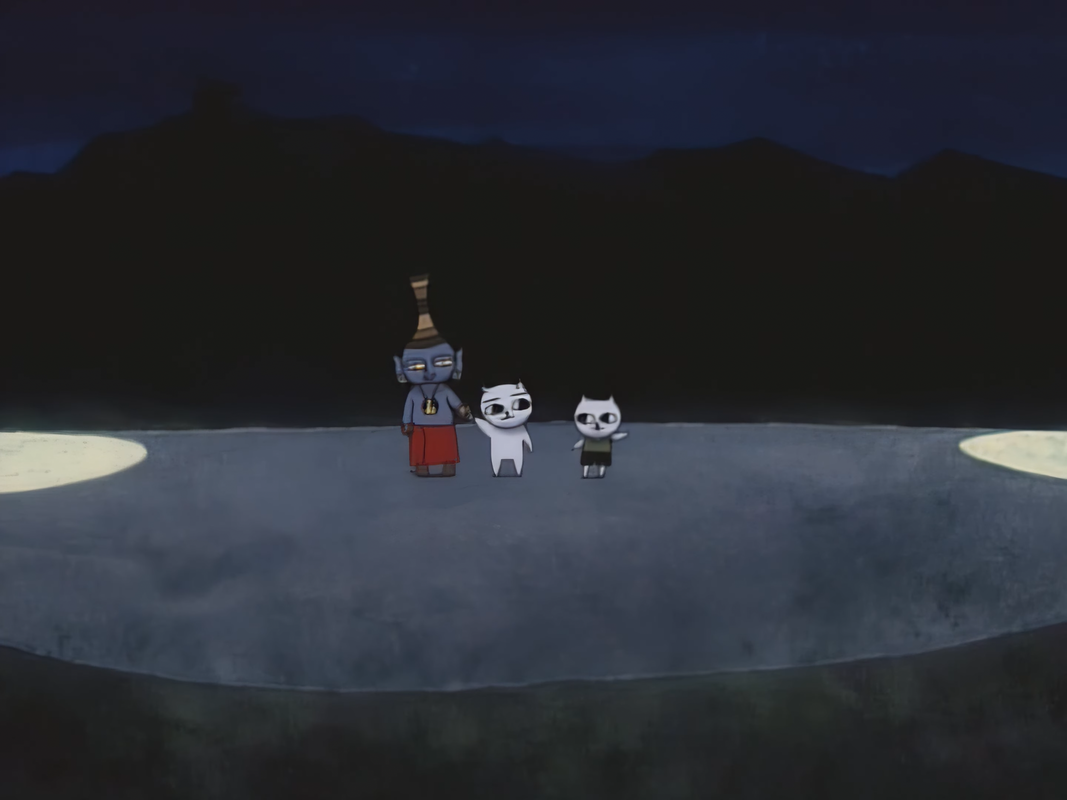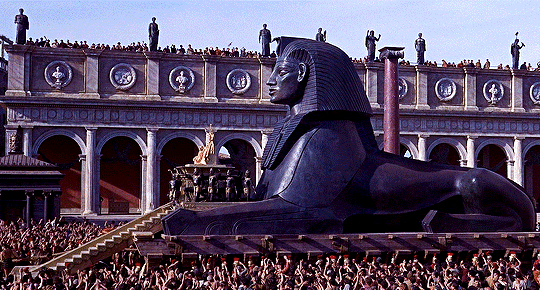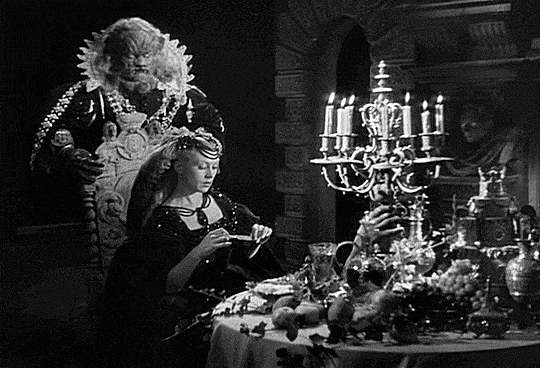“Are the birds gonna eat us, Mommy?”The Birds (Alfred Hitchcock, 1963)
Sep
10
chicken

Alfred Hitchcock and Tippi Hedren in a promotional photo by Philippe Halsman. Hedren, as her character Melanie Daniels, is attacked by a large crow while Hitchcock calmly enjoys a fried chicken and a glass of wine. DP: Robert Burks.
Feeling rather peckish.
bookadaptation
– You want a leg or a breast? – You make the choice.To Catch a Thief (Alfred Hitchcock, 1955)
Sep
8
leg or breast

Francie (Grace Kelly) and John Robie (Cary Grant) taking a (lunch) break on the Grand Corniche coast road. DP: Robert Burks.
“I've got it. Film star! You'd be perfect. Dark glasses, lots of red lipstick, and 100,000 rupees per picture. And if it's a Hindi film, we'll all fly to Bombay.”মহানগর [Mahanagar / The Big City] (Satyajit Ray, 1963)
Sep
6
freebie: National Lipstick Day

Edith (Vicky Redwood) applying colour to Arati's (Madhavi Mukherjee) lips. DP: Subrata Mitra.
Set in 1950s Calcutta, মহানগর is a story of emancipation in a changing society. Arati (Madhavi Mukherjee) is a housewife from a traditionalist family, who – in order to support her relatives' lavish demands – goes out to work as a door-to-door saleswoman. Slowly, she discovers her independence.
– Bani
ねこぢる草 [Nekojiru-sō / Cat Soup] (Tatsuo Satō, 2001)
Aug
30
National Grief Awareness Day

Nyāko taken away by Jizō with little brother Nyatta telling Nyāko to come back home. DP: Masaru Takase.
Nyatta is not ready to have Jizō take away his big sister Nyāko to Ne-no-kuni, the land of the dead. The kitten grabs his sister's paw, resulting in her soul being ripped in two and leaving Nyāko in a state of limbo. The cats' mother then sends the two off on a mission to buy fried #tofu. Maybe now Nyatta can find a way to put Nyāko's divided soul back together. But first, there's a circus to visit!
ねこぢる草 is based on works by mangaka Nekojiru / ねこぢる (1967—1998) whose trademark crudely drawn #cats caused a ripple in Japan's underground #manga circuit. Nyatta and Nyāko continued their surreal adventures by way of widower Yamano Hajime after Nekojiru's tragic suicide in 1998.
“There are never enough hours in the days of a queen, and her nights have too many.” Cleopatra (Joseph L. Mankiewicz + Rouben Mamoulian, 1963)
Aug
26
National Spark The World Day

Cleopatra's – Elizabeth Taylor, anachronistically dressed as the goddess Nekhbet – grande entrée in Rome. She sits on top of a black, basalt-like sphinx, pulled by numerous slaves and greeted by a cast of thousands. There are 20 000 Italian extras; there's no CGI. DPs: Leon Shamroy & Jack Hildyard.
Like Rome, Cleopatra wasn't built in a day. Joseph L. Mankiewicz's epic studio breaker took six years to make and, despite it being the highest-grossing film of 1963, didn't break even until 1973. Was it a #flop? A classic flop but a flop nevertheless?
– Cleopatra
The star – the Queen – Elizabeth Taylor demanded an unprecedented one million dollar fee, 10,3 million in 2023 US dollars. Liz's movie dressing table hold trinkets especially designed by luxury brand Bulgari, blink and you'll miss them. The Pharaoh's lavish costumes, all 65 of them (created by Irene Sharaff who would dress Taylor again as #Cleopatra's counterpart Martha in Who's Afraid of Virginia Woolf? (1966)), cost almost 195K dollar (ca. 2 million today), and of course those 20 000 extras, shipped from God-knows-where to Hollywood on the Tiber to shoot one scene, had to look like their 2000 year old counterparts, and be fed, and housed.
Is it all bad? Cleopatra is one of those movies that so many – and that includes obsessive cinephiles – will get around to watch. Eventually. All four hours of it. I'm still holding out, but ooh, the spectacle!
“Do you want to work? What a nightmarish idea” Οι Τεμπέληδες της Εύφορης Κοιλάδας [Oi tembelides tis eforis koiladas / The Idlers of the Fertile Valley] (Nikos Panayotopoulos, 1978)
Aug
21
freebie: World Sleep Day

The maid, father, and two of the sons in a drab, dark green corridor. The men wear burgundy red dressing gowns over their pyjamas and lethargically lean instead of actively sit or stand. The maid wears practical everyday wear and has something to discuss. DP: Andreas Bellis.
Slow cinema of a different kind. We spend long hours in the company of a father (Vasilis Diamantopoulos) and his sons Sakis (George Dialegmenos), Nikos (Dimitris Poulikakos), and Giannis (Nikitas Tsakiroglou). The four of them – rich, bourgeois – have inherited a country villa and the plan is to do nothing for the next seven years. No work, no unnecessary movements. There's #sleep, lots of it. And copious amounts of food prepared by maid Sofia (Olga Karlatos) – she comes with the house; chattels personal – in addition of her body to be consumed by the increasingly idle men.
Οι Τεμπέληδες της Εύφορης Κοιλάδας is a slow satire, quietly addressing Greek #class struggle through the viewer's observation. Who do we follow? The father, who quickly surrenders to sloth; the sons – young, with their whole lives ahead of them; the maid – never questioning her position and slavishly fulfilling her duties of the flesh, in bed and in the kitchen?
The similarities are there but unlike Marco Ferreri's La grande bouffe (1973), there's no culmination in decadence. No euphoria to speak of. No grand release either; while the camera roams the mansion, attuned to #Mahler's tone poem Symphony No. 1 [Titan] – our only clue of the passing of time; even the vegetation succumbs to ennui – the story plods on. One of the men gets dressed, to go to work. It's foolish.
– What do you want from this house?
– Want?
– Yes. Want.
– I'm just the servant, miss.
– Get my lunch.The Servant (Joseph Losey, 1963)
Aug
16
National Authenticity Day

Manservant Barrett (Dirk Bogarde) and his master Tony (James Fox). Tony is asleep in a folding chair wearing an overcoat in a sparse room with crumbling walls. Barrett – immaculately dressed in a dark overcoat, hat, gloves, tie – stands in the doorway, looking down on the sleeping man. DP: Douglas Slocombe.
Maléfices [Where the Truth Lies] (Henri Decoin, 1962)
Aug
16
milk

Ronga (Maîthé Mansoura accompanied by cheetah Nyète), sits on a straw-covered floor while holding a bowl with milk. There are potted plants and gardening equipment is placed against the wall. DP: Marcel Grignon.
– Does he crawl on four legs? What does he eat and drink? – I've given him water to drink on occasion. He would never eat me.La Belle et la Bête [Beauty and the Beast] (Jean Cocteau + René Clément, 1946)
Aug
15
a cornucopia of wonder

La Belle (Josette Day) at a fancy table stacked with good foods and nice wines. She's cleaning her fingernails with the silverware while a chagrined Bête (Jean Marais) looks on. As magical as the story are the production and set design by Christian Bérard, Lucien Carré, and René Moulaert. They breathed a soul into almost everything, including the candelabras. DP: Henri Alekan.
